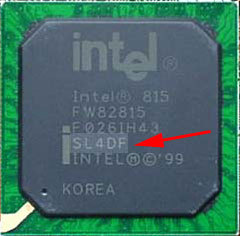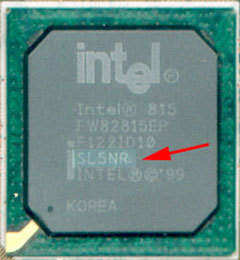Last Passing Maneuver: Tualatin 1266 With 512 kB Versus Athlon And P4
B-Stepping With The I815/Solano
At first glance it seems to the user as though the Tualatin were behaving like a classic Pentium III and thus making do with the same chipset. But this is only partly right. The Tualatin is completely unsuited to older socket-370 chipsets like the 440BX, the i810/Whitney or the i820/Camino. Not even a socket-to-socket adapter that would adapt the voltage or the pins accordingly would help. The main difference is the bus protocol that has been switched from AGTL+ to AGTL (AGTL = Assisted Gunning Transceiver Logic). The only chipset that Intel has revived is the i815/Solano. The necessary logic is included in what is known as B-Stepping .
The unpracticed eye will find it difficult to tell the difference between the old A2-stepping Solano and the new B0, because the imprint on the first two lines is identical. Only the fourth line will give you a clue. This number allows you to tell the version. We compiled this table for the two major versions of the 815 chipset, one with integrated graphics (82815-Northbridge) and the other without a graphic core (82815EP ).
| Chipset | Stepping | S-Spec | Top Marking | Tualatin-Support |
|---|---|---|---|---|
| i815 | A2 | SL4DF | FW82815 | no |
| i815 | B0 | SL5NQ | FW82815 | yes |
| i815EP | A2 | SL552 | FW82815EP | no |
| i815EP | B0 | SL5NR | FW82815EP | yes |
The S-spec is critical. You will find it on the fourth line of the Northbridge chipset.
SL4DF means that this chipset was manufactured according to the old A2 stepping process (see table above).
According to the table on the last page, the SL5NR conceals the new B0 stepping. This version is the right one for the PIII Tualatin.
Get Tom's Hardware's best news and in-depth reviews, straight to your inbox.
Current page: B-Stepping With The I815/Solano
Prev Page 10 New Pins Next Page VIA Is Clear: T Positioned In The Rear

